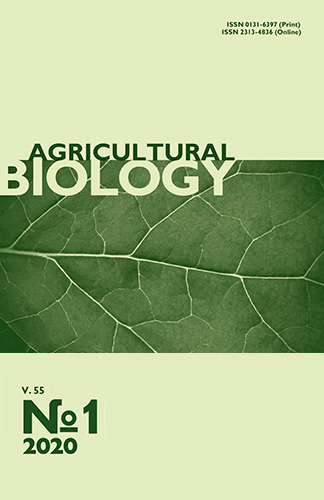doi: 10.15389/agrobiology.2020.1.118eng
UDC: 582.663.2:631.811.98
PROPERTIES OF СREZACIN AS A GROWTH STIMULANT
OF VEGETABLE AMARANTH (Amaranthus L.)
L.L. Kirillova1, G.N. Nazarova2, A.M. Peshkova1, E.P. Ivanova2
1Tolstoy Tula State Pedagogical University, 125, prosp. Lenina, Tula, 300026 Russia, e-mail kirillova56@inbox.ru, alisapeshkova78@mail.ru;
2Institute of Basic Biological Problems, 2, ul. Institutskaya, Pushchino, Moscow Province, 142290 Russia, e-mail no-reply@researchgatemail.net, cheredova@mail.ru (✉ corresponding author)
ORCID:
Kirillova L.L. orcid.org/0000-0003-3552-6590
Peshkova A.M. orcid.org/0000-0002-9787-6716
Nazarova G.N. orcid.org/0000-0002-0244-2238
Ivanova E.P. orcid.org/0000-0002-2161-9035
Received May 29, 2019
Сrezacin, tris(2-oxyethyl)ammonium ortho-cresoxy acetate-based adaptogen of humans and animals, is applied in Russia as a stimulant of growth and productivity of crops (wheat, oats, spinach, potatoes, etc.). In other countries, crezacin is not used for these purposes. There is no information about its use in the cultivation of food amaranth (Amaranthus L.), a source of high-quality protein and other useful substances. In this paper, we first report data on the effect of pre-sowing treatment with crezacin on seed germination, development and biometric parameters of amaranth plants during ontogenesis, and on their productivity and nutritive value. Our findings indicate the ability of crezacin to increase nitrate reductase activity, to influence the nitrite nitrogen content in the early stages of vegetation, to increase the electron transport rate ATP synthesis. The aim of the work was to assess the effect of different crezacin concentrations on seed germination, seedling quality, growth parameters, and activity of photosynthesis and nitrogen assimilation apparatus. Seeds of Amaranthus caudatus L. (sample K173) and Amaranthus cruenthus L. (sample K185) were soaked for 1 day in crezacin solutions (test) or in distilled water (control), and used in the experiments after air-drying at room temperature. In experiment 1, 10-10 до 10-5 M aqueous crezacin was applied to seeds then allowed for germination on wet filter paper in Petri dishes for 72 h at 24 °С. The proportion of germinated seeds was calculated. In experiment 2, we studied the effect of crezacin on the growth and physiological and biochemical parameters of plants. Seeds were treated with 10-7 M crezacin, germinated, and calibrated seedlings were transplanted into sand- filled container. Biometric parameters were measured every 15 days until harvest (120 days), productivity was estimated by the green mass increase. Chlorophyll concentration was assessed in the leaves of 45-day-old plants. The photochemical activity of isolated chloroplasts was evaluated by the rate of electron transport and photophosphorylation. From day 15 to day 45, the activity of nitrate reductase, the concentrations of N-NO2 and total protein were measured in the leaves. The net photosynthesis (NP) for the period from day 45 to day 60 was calculated by A.A. Nichiporovich’s method. Experiment 1 revealed a change in seed germination depending on the concentration of the preparation in both studied samples. A 10-8 concentration increased seed germination capacity by 10 % compared to control (P = 0.95), 10-7 M had maximum stimulating effect (by 25 %), and at 10-5 M the germination rate decreased by 22 %. Other concentrations had no significant effect. In experiment 2, in both varieties during latent growth stage the seedlings from the treated seeds were twice as high as the control, and the length of the main root was 1.6 times as much as in control. During later stages, the green mass of plants in the experiment exceeded the control 1.3-2.0-fold depending on the phase of ontogenesis. The treatments did not affect the height of plants. The NF value in leaves after treatment exceeded the control by 26 % (P = 0.95). At the same time, the chlorophyll content in the leaves did not change, and the electron transport rate in chloroplasts increased by more than 30 % while photophosphorylation by 60 %. The nitrate reductase activity in leaves on day 45 increased by almost 60 %, the total protein level by 20 %, and nitrite nitrogen amount by 16 % (P = 0.95). These findings indicate the stimulating effect of crezacin on amaranth seeds, plant growth, photosynthesis and protein synthesis, which leads to an increase in the productivity and nutritional value of plants.
Keywords: tris(2-oxyethyl)ammonium ortho-cresoxy acetate, crezatsin, amaranth, seed germination, plant growth regulation, photophosphorylation, electron transport, protein content, nitrate reductase, productivity, nutritional value.
REFERENCES
- Voronkov M.G., Rasulov M.M. Khimiko-farmatsevticheskii zhurnal, 2007, 41(1): 3-7 CrossRef (in Russ.).
- Muromtsev G.S., Chkanikov D.I., Kulaeva O.N., Gamburg K.Z. Osnovy khimicheskoi regulyatsii rosta i produktivnosti rastenii [Fundamentals of chemical regulation of plant growth and productivity]. Moscow, 1987 (in Russ.).
- Gosudarstvennyi katalog pestitsidov i agrokhimikatov, razreshennykh k primeneniyu na territorii rossiiskoi federatsii. Chast’ I. Pestitsidy [The state catalog of pesticides and agrochemicals approved for use on the territory of the Russian Federation. Part I. Pesticides]. Moscow, 2015 (in Russ.).
- Kononkov P.F., Gins V.K., Gins M.S. Amarant — perspektivnaya kul'tura XXI veka [Amaranth — a promising culture of the XXI century]. Moscow, 1999 (in Russ.).
- Saubhik D. Amaranthus: a promising crop of future. Springer, Singapore, 2016 CrossRef
- Kraujalis P., Venskutonis P.R, Kraujalienė V., Pukalskas A. Antioxidant properties and preliminary evaluation of phytochemical composition of different anatomical parts of amaranth. Plant Foods Hum. Nutr., 2013, 68(3): 322-328 CrossRef
- Léder I. Buckwheat, amaranth and other pseudocereal plants. In: Cultivated plants, primarily as food sources. Encyclopedia of life support systems. Vol. I. G. Fuleky (ed.). EOLSS Publications, 2009.
- Achigan-Dako E.G., Sogbohossou O.E.D., Maundu P. Current knowledge on Amaranthus spp.: research avenues for improved nutritional value and yield in leafy amaranths in sub-Saharan Africa. Euphytica, 2014, 197(3): 303-317 CrossRef
- Janovská D., Čepková P.H., Džunková M. Characterisation of the amaranth genetic resources in the Czech gene bank. In: Genetic diversity in plants. M. Caliskan (ed.). Publisher Technology, 2012: 457-478 CrossRef
- Pandey R.M. Biotechnological advances in amaranths species and their future outlook in crop improvement — a review. Recent Patents on DNA & Gene Sequences, 2013, 7(3): 179-86 CrossRef
- Shukla S., Pandey V., Pachauri G. Nutritional contents of different foliage cuttings of vegetable amaranth. Plant Foods Hum. Nutr., 2003, 58(3): 1-8 CrossRef
- Shukla S., Bhargava A., Chatterjee A., Srivastava J., Singh N., Singh S.P. Mineral profile and variability in vegetable amaranth (Amaranthus tricolor). Plant Foods Hum. Nutr., 2006, 61(1): 21-26 CrossRef
- Icard-Vernière Ch., Olive F., Picq Ch., Mouquet-Rivier C. Contribution of leafy vegetable sauces to dietary iron, zinc, vitamin A and energy requirements in children and their mothers in Burkina Faso. Plant Foods Hum. Nutr., 2015, 70(1): 63-70 CrossRef
- Noumedem J.A., Mihasan M., Lacmata S.T., Stefan M., Kuiate J.R., Kuete V. Antibacterial activities of the methanol extracts of ten Cameroonian vegetables against Gram-negative multidrug-resistant bacteria. BMC Complementary and Alternative Medicine, 2013, 13: 26 CrossRef
- Negi P.S., Roy S.K. Changes in β-carotene and ascorbic acid content of fresh amaranth and fenugreek leaves during storage by low cost technique. Plant Foods Hum. Nutr., 2003, 58(3): 225-230 CrossRef
- Ortega J.A.A., Zavala A.M., Hernández M.C., Reyes J.D. Analysis of trans-fatty acids production and squalene variation during amaranth oil extraction. Open Chemistry, 2012, 10(6): 1773-1778 CrossRef
- Tang Y., Tsao R. Phytochemicals in quinoa and amaranth grains and their antioxidant, anti-inflammatory and potential health beneficial effects: a review. Mol. Nutr. Food Res., 2017, 61(7): 1600767 CrossRef
- Martirosyan D.M., Miroshnichenko L.A., Kulakova S.N., Pogojeva A.V., Zoloedov V.I. Amaranth oil application for coronary heart disease and hypertension. Lipids in Health and Disease, 2007, 6(1): 1-12 CrossRef
- Bavec F., Mlakar S.G. Effects of soil and climatic conditions on emergence of grain amaranths. European Journal of Agronomy, 2002, 17(2): 93-103 CrossRef
- Aufhammer W., Czuczorova D., Kaul H.P., Kruse M. Germination of grain amaranth (Amaranthus hypochondriacus ½ A. hybridus): effects of seed quality, temperature, light, and pesticides. European Journal of Agronomy, 1998, 8(1-2): 127-135 CrossRef
- Chernov I.A. Amarant — fiziologo-biokhimicheskie osnovy introduktsii [Amaranth — physiological and biochemical basics of introduction]. Kazan', 1992 (in Russ.).
- Bürger J., de Mol F., Gerowitt B. Influence of cropping system factors on pesticide use intensity — a multivariate analysis of on-farm data in North East Germany. European Journal of Agronomy, 2012, 40: 54-63 CrossRef
- Ivanova E.P., Kirillova L.L., Smolygina L.D., Serdyuk O.P. A new natural stimulator 4-hydroxyphenethyl alcohol effects on amaranth seeds germination and plant productivity. Sel'skokhozyaistvennaya biologiya [Agricultural Biology], 2011, 5: 118-122 (in Russ.).
- Ivanova E.P., Kirillova L.L., Nazarova G.N. Gibbersib effects on amaranth seeds germination and plant productivity. Sel'skokhozyaistvennaya biologiya [Agricultural Biology], 2014, 1: 91-97 CrossRef (in Russ.).
- Kirillova L.L., Nazarova G.N., Ivanova E.P. para-Aminobenzoic acid stimulats seed germination, plant growth, development, photosynthesis and nitrogen assimilation in the amaranth (Amaranthus L.). Sel'skokhozyaistvennaya biologiya [Agricultural Biology], 2016, 51(5): 688-695 CrossRef
- Voronkov M.G., Dolmaa G., Tserenpil Sh., Ugtakhbayar O., Chimidtsogzol A. Stimulation of barley seed germination by micromolar aqueous solutions of silatrane and cresacin. Dokl. Biol. Sci., 2005, 404: 367-369.
- Bairambekov Sh.B., Korinets V.V., Valeeva Z.B., Dubrovin N.K, Bicherev V.A., Korneva O.G., Polyakova E.V. Shlyakhov V.A., Kufaev A.A., Dubin R.I., Gerasimov P.V. Tekhnologiya proizvodstva kartofelya v astrakhanskoi oblasti [Potato production technology in the Astrakhan region]. Astrakhan', 2007 (in Russ.).
- Polovinkin V.G., Isaichev V.A., Provalova E.V. Izvestiya Nizhnevolzhskogo agrouniversitetskogo kompleksa: nauka i vysshee professional'noe obrazovanie, 2013, 1(29): 95-101 (in Russ.).
- Isaichev V.A., Andreev N.N., Kaspirovskii A.V. Vestnik Ul'yanovskoi gosudarstvennoi sel'skokhozyaistvennoi akademii, 2013, 3(23): 14-19 (in Russ.).
- Stepanov A.F., Milashenko A.V., Prokhorova N.A. Omskii nauchnyi vestnik, 2012, 2(114): 179-184 (in Russ.).
- Kunavin G.A., Kuznetsov N.N. Agrarnyi vestnik Urala, 2013, 4(110): 53-55 (in Russ.).
- Wintermans J.F.G.M., De Mots A. Spectrophotometric characteristics of chlorophyll a and b and their pheophytins in ethanol. Biochimica et Biophysica Acta (BBA) — Biophysics including Photosynthesis, 1965, 109(2): 448-453 CrossRef
- West K.R., Wiskich J.T. Photosynthetic control by isolated pea chloroplasts. Biochem. J., 1968, 109(4): 527-532.
- Izava S., Good N.E. Hill reaction rates and chloroplasts fragment size. Biochimica et Biophysica Acta (BBA) — Biophysics including Photosynthesis, 1965, 109(2): 372-381.
- Tumerman L.A., Fedorovich I.B. V knige: Bioenergetika i biologicheskaya spektrofotometriya [Bioenergy and biological spectrophotometry]. Moscow, 1967: 35-40 (in Russ.).
- Hageman R.H., Reed A.J. Nitrate reductase from higher plants. Methods in Enzymology, 1980, 69: 270-280 CrossRef
- Bradford M.M. Rapid and sensitive gram quantities of protein utilizing the principle of protein-dye binding. Analytical Biochemistry, 1976, 72(1-2): 248-254 CrossRef
- Nichiporovich A.A. Fotosinteticheskaya deyatel'nost' rastenii kak osnova ikh produktivnosti v biosfere i zemledelii [Photosynthetic activity of plants as the basis of their productivity in the biosphere and agriculture]. Moscow, 1988 (in Russ.).
- Plant hormones: biosynthesis, signal transduction, action! P.J. Davies (ed.). Kluwer Academic Publishers, London, 2004.
- Bektas Y., Eulgem T. Synthetic plant defense elicitors. Front. Plant Sci., 2015, 26(5): 804 CrossRef
- Cheeseman J.M., Tankou S.K. Nitrate reductase and growth of Arabidopsis thaliana in solution culture. Plant and Soil, 2005, 266(1-2): 143-154 CrossRef












